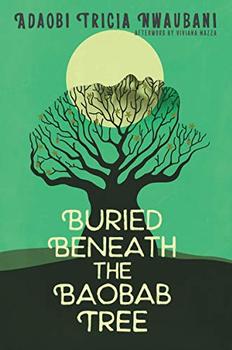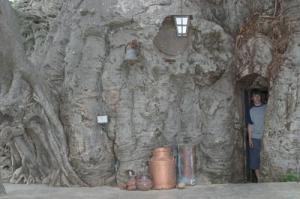Summary | Excerpt | Reviews | Beyond the Book | Read-Alikes | Genres & Themes | Author Bio

This article relates to Buried Beneath the Baobab Tree
 A prominent symbol in Buried Beneath the Baobab Tree, the mighty baobab tree sparks the imagination because of its unusual shape and longevity. Traditional Shona myth explains that the tree showed too much pride and was always whining and calling other creatures bad names, so the creator turned it upside-down as punishment, hence it stands today with many root-like branches reaching to the sky.
A prominent symbol in Buried Beneath the Baobab Tree, the mighty baobab tree sparks the imagination because of its unusual shape and longevity. Traditional Shona myth explains that the tree showed too much pride and was always whining and calling other creatures bad names, so the creator turned it upside-down as punishment, hence it stands today with many root-like branches reaching to the sky.
Traditional medicinal lore ascribes powerful properties to the sacred baobab. Some say that baby boys who bathe in water infused with baobab bark will grow up strong. Others say that if you pick a baobab flower, you will be eaten by a lion; conversely, if you drink water infused with the seeds, you'll be protected from crocodile attacks. In some regions, couples like to marry beneath the baobab, believing it bestows fertility.
 Baobabs are deciduous, and function as prominent players in the ecosystem. Trees may live more than 2,000 years and can grow both taller and wider than 100 feet. They're especially visible because of their unusual, bulbous trunks and are native to Sub-Saharan Africa, Madagascar and Australia. In Madagascar, the species Adonsonia grandidieri grows in groves with a distinctively tall, sculptured trunk and is a much-photographed tourist attraction. Baobab have also been cultivated (but are not native) in South Asia, the Americas and China.
Baobabs are deciduous, and function as prominent players in the ecosystem. Trees may live more than 2,000 years and can grow both taller and wider than 100 feet. They're especially visible because of their unusual, bulbous trunks and are native to Sub-Saharan Africa, Madagascar and Australia. In Madagascar, the species Adonsonia grandidieri grows in groves with a distinctively tall, sculptured trunk and is a much-photographed tourist attraction. Baobab have also been cultivated (but are not native) in South Asia, the Americas and China.
 Birds, reptiles, and small mammals such as monkeys nest in the baobab's branches. Bark can be peeled (without killing the tree) and woven into rope, baskets, cloth or hats. Weaver birds create basketlike nests that hang from their tallest branches, safely out of reach of browsing animals. The elaborate, night-blooming flowers attract bats for pollination. Baobab fruit is edible to humans and other creatures. Elephants munch the foliage and fibrous bark. Leaves & seeds are used for creams and skin ointments. Various components are crafted into remedies for stomach upset, insect bites and pain, among other ailments. There's an emerging niche market for using baobab fruit or dried powder as a superfood because of its high levels of vitamin C, calcium, fiber and antioxidants. As mentioned in Buried Beneath the Baobab Tree, baobab leaves are used to prepare traditional soup, breads and beverages.
Birds, reptiles, and small mammals such as monkeys nest in the baobab's branches. Bark can be peeled (without killing the tree) and woven into rope, baskets, cloth or hats. Weaver birds create basketlike nests that hang from their tallest branches, safely out of reach of browsing animals. The elaborate, night-blooming flowers attract bats for pollination. Baobab fruit is edible to humans and other creatures. Elephants munch the foliage and fibrous bark. Leaves & seeds are used for creams and skin ointments. Various components are crafted into remedies for stomach upset, insect bites and pain, among other ailments. There's an emerging niche market for using baobab fruit or dried powder as a superfood because of its high levels of vitamin C, calcium, fiber and antioxidants. As mentioned in Buried Beneath the Baobab Tree, baobab leaves are used to prepare traditional soup, breads and beverages.
 The massive trunks store thousands of gallons of water and can be tapped into during the dry season. Famously, South African landowners turned the hollow space in the Sunland Baobab into a pub until 2017, when the landmark tree mysteriously broke apart and toppled. It was rumored to be the continent's largest baobab. Unfortunately, several other celebrity baobabs have also died during the past decade, and scientists are investigating the causes. Climate change? Human impact? Or maybe the trees are simply worn out, exhausted from their remarkably long lifespan.
The massive trunks store thousands of gallons of water and can be tapped into during the dry season. Famously, South African landowners turned the hollow space in the Sunland Baobab into a pub until 2017, when the landmark tree mysteriously broke apart and toppled. It was rumored to be the continent's largest baobab. Unfortunately, several other celebrity baobabs have also died during the past decade, and scientists are investigating the causes. Climate change? Human impact? Or maybe the trees are simply worn out, exhausted from their remarkably long lifespan.
 Baobab can be cultivated, although they're sensitive to climate and require up to 100 years before fruiting, and researchers are experimenting with grafting to speed up the process. A hopeful micro-enterprise is underway in the Limpopo Province, South Africa, where an organization called Baobab Guardians encourages village women to plant and nurture baobab seedlings until they're viable in the wild. These women – under the mentorship of botanist/forester Dr. Sarah Venter – protect the transplants from browsing animals and are compensated for their work. They also gather nutrient-rich baobab pods from mature trees, selling them to earn a modest cash income in a region where subsistence farming is the main livelihood and families often struggle to feed and educate their children.
Baobab can be cultivated, although they're sensitive to climate and require up to 100 years before fruiting, and researchers are experimenting with grafting to speed up the process. A hopeful micro-enterprise is underway in the Limpopo Province, South Africa, where an organization called Baobab Guardians encourages village women to plant and nurture baobab seedlings until they're viable in the wild. These women – under the mentorship of botanist/forester Dr. Sarah Venter – protect the transplants from browsing animals and are compensated for their work. They also gather nutrient-rich baobab pods from mature trees, selling them to earn a modest cash income in a region where subsistence farming is the main livelihood and families often struggle to feed and educate their children.
Baobab Tree (Adansonia gregorii)
Baobab Tree (Adansonia digitata)
Two photos of Sunland Baobab
Baobab Guardians
Filed under Nature and the Environment
![]() This "beyond the book article" relates to Buried Beneath the Baobab Tree. It originally ran in October 2018 and has been updated for the
March 2020 paperback edition.
Go to magazine.
This "beyond the book article" relates to Buried Beneath the Baobab Tree. It originally ran in October 2018 and has been updated for the
March 2020 paperback edition.
Go to magazine.
If we did all the things we are capable of, we would literally astound ourselves
Click Here to find out who said this, as well as discovering other famous literary quotes!
Your guide toexceptional books
BookBrowse seeks out and recommends the best in contemporary fiction and nonfiction—books that not only engage and entertain but also deepen our understanding of ourselves and the world around us.